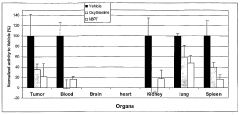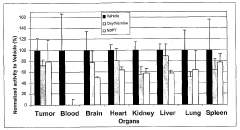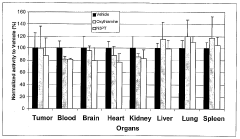Pentose Phosphate Pathway and Disease: Future Directions
Research Background and Objectives
The Pentose Phosphate Pathway (PPP) is a fundamental metabolic pathway that plays a crucial role in cellular metabolism and redox homeostasis. Discovered in the 1950s, the PPP has been the subject of extensive research due to its significance in various physiological processes and its potential implications in disease states.
The pentose phosphate pathway operates parallel to glycolysis and serves two primary functions: the generation of reducing equivalents in the form of NADPH and the production of ribose-5-phosphate, a precursor for nucleotide synthesis. These functions make the PPP essential for cellular processes such as biosynthesis, antioxidant defense, and cell proliferation.
Over the years, our understanding of the PPP has evolved significantly. Initially viewed as a simple alternative to glycolysis, it is now recognized as a complex and dynamic pathway that interacts with various other metabolic processes. Recent advancements in metabolomics and systems biology have shed light on the intricate regulation of the PPP and its cross-talk with other pathways.
The objective of exploring the PPP in the context of disease is multifaceted. Firstly, it aims to elucidate the role of PPP dysregulation in the pathogenesis of various diseases, including cancer, diabetes, and neurodegenerative disorders. Understanding these connections can provide valuable insights into disease mechanisms and potential therapeutic targets.
Secondly, research in this area seeks to leverage the PPP as a diagnostic tool. Alterations in PPP flux or enzyme activities could serve as biomarkers for early disease detection or progression monitoring. This approach holds promise for improving disease management and personalized medicine strategies.
Thirdly, the PPP is being investigated as a target for therapeutic interventions. Modulating PPP activity could potentially mitigate oxidative stress, alter cellular metabolism, or influence cell proliferation, offering new avenues for disease treatment.
As we look towards future directions, several key areas of focus emerge. One is the exploration of tissue-specific variations in PPP activity and regulation, which could explain differential disease susceptibility and progression across organs. Another is the investigation of PPP's role in cellular senescence and aging, processes that underlie many chronic diseases.
Furthermore, the advent of advanced technologies such as CRISPR-Cas9 gene editing and single-cell metabolomics presents opportunities for more precise manipulation and analysis of the PPP. These tools may enable researchers to unravel the complex interplay between the PPP and other cellular processes at unprecedented resolution.
In conclusion, the study of the Pentose Phosphate Pathway in the context of disease represents a dynamic and promising field of research. By deepening our understanding of this crucial metabolic pathway, we stand to gain valuable insights into disease mechanisms, develop novel diagnostic tools, and uncover innovative therapeutic strategies for a wide range of pathological conditions.
Market Analysis for PPP-Related Therapeutics
The market for therapeutics related to the Pentose Phosphate Pathway (PPP) is experiencing significant growth, driven by increasing understanding of the pathway's role in various diseases. The PPP, a crucial metabolic pathway, is involved in numerous cellular processes, including the generation of NADPH for biosynthesis and protection against oxidative stress. As research continues to uncover the pathway's importance in diseases such as cancer, diabetes, and neurodegenerative disorders, the demand for PPP-related therapeutics is expected to rise substantially.
In the oncology sector, PPP inhibitors are gaining traction as potential anti-cancer agents. The pathway's upregulation in many cancer types makes it an attractive target for therapeutic intervention. Several pharmaceutical companies are investing in the development of drugs that target key enzymes in the PPP, such as glucose-6-phosphate dehydrogenase (G6PD) and transketolase. These efforts are likely to expand the market for PPP-related cancer therapeutics in the coming years.
The diabetes market also presents significant opportunities for PPP-related therapeutics. The pathway's role in glucose metabolism and its potential to modulate insulin sensitivity have sparked interest in developing drugs that can regulate PPP activity. As the global prevalence of diabetes continues to increase, the demand for novel treatment approaches targeting the PPP is expected to grow.
Neurodegenerative disorders represent another promising area for PPP-related therapeutics. Research has shown that the PPP plays a crucial role in maintaining neuronal health and protecting against oxidative stress. This has led to increased interest in developing drugs that can enhance PPP activity in the brain, potentially slowing or halting the progression of diseases such as Alzheimer's and Parkinson's.
The market for PPP-related therapeutics is also benefiting from advancements in drug delivery technologies and personalized medicine approaches. These innovations are enabling the development of more targeted and effective treatments that can modulate PPP activity in specific tissues or cell types.
Geographically, North America and Europe currently dominate the market for PPP-related therapeutics, owing to their strong research infrastructure and high healthcare expenditure. However, the Asia-Pacific region is expected to witness rapid growth in this market, driven by increasing investment in biotechnology research and rising healthcare awareness.
Despite the promising outlook, the market for PPP-related therapeutics faces challenges such as the complexity of the pathway and potential off-target effects. Overcoming these hurdles will require continued investment in research and development, as well as close collaboration between academia and industry.
Current PPP Research Challenges
The Pentose Phosphate Pathway (PPP) plays a crucial role in cellular metabolism, yet several challenges persist in current research efforts. One of the primary obstacles is the complexity of the pathway's regulation in different tissues and disease states. Researchers struggle to fully elucidate the intricate mechanisms controlling PPP flux under various physiological and pathological conditions.
Another significant challenge lies in the development of specific and sensitive tools for measuring PPP activity in vivo. Current methods often rely on indirect measurements or require invasive procedures, limiting our ability to accurately assess PPP function in real-time and in intact organisms. This hampers our understanding of the pathway's dynamic responses to various stimuli and its role in disease progression.
The interconnectedness of the PPP with other metabolic pathways poses additional difficulties in isolating its specific contributions to cellular processes. Researchers face the challenge of disentangling the effects of PPP modulation from those of related pathways, such as glycolysis and the tricarboxylic acid cycle. This complexity makes it challenging to develop targeted therapeutic interventions without unintended consequences on overall cellular metabolism.
Furthermore, the role of PPP in specific diseases remains incompletely understood. While its involvement in cancer, diabetes, and neurodegenerative disorders has been established, the exact mechanisms by which PPP dysregulation contributes to disease pathogenesis are not fully elucidated. This gap in knowledge hinders the development of effective therapeutic strategies targeting the pathway.
The genetic and epigenetic factors influencing PPP activity represent another area of ongoing research challenges. Identifying and characterizing the regulatory elements controlling PPP gene expression and enzyme activity across different cell types and disease states remains a complex task. This knowledge is crucial for understanding individual variations in PPP function and developing personalized therapeutic approaches.
Lastly, translating findings from in vitro and animal studies to human patients presents a significant hurdle. The differences in PPP regulation and function between model organisms and humans necessitate careful validation of research findings before clinical application. Developing appropriate human cell and tissue models that accurately recapitulate PPP dynamics in vivo is an ongoing challenge in the field.
Current Targeting Strategies for Pentose Phosphate Pathway
01 Genetic engineering of the pentose phosphate pathway
Genetic modifications are made to enhance or alter the pentose phosphate pathway in microorganisms. This can involve introducing new genes, modifying existing ones, or altering regulatory elements to improve flux through the pathway. Such modifications can lead to increased production of desired metabolites or improved utilization of pentose sugars.- Genetic engineering of the pentose phosphate pathway: Genetic modifications are made to enhance or alter the pentose phosphate pathway in microorganisms. This can involve introducing new genes, modifying existing ones, or altering regulatory elements to improve flux through the pathway. Such modifications can lead to increased production of desired metabolites or improved utilization of pentose sugars.
- Metabolic engineering for improved pentose utilization: Strategies are developed to enhance the ability of microorganisms to utilize pentose sugars, particularly in the context of biofuel production. This can involve optimizing enzymes in the pentose phosphate pathway, introducing heterologous pathways, or modifying sugar transport systems to improve pentose uptake and metabolism.
- Regulation and control of the pentose phosphate pathway: Research focuses on understanding and manipulating the regulatory mechanisms of the pentose phosphate pathway. This includes studying transcriptional and post-translational regulation, metabolic flux analysis, and developing methods to control pathway activity for desired outcomes in biotechnology applications.
- Applications in metabolite production: The pentose phosphate pathway is exploited for the production of various valuable metabolites. This can include the synthesis of aromatic compounds, nucleotides, amino acids, or other industrially relevant molecules. Strategies involve redirecting carbon flux through the pathway to enhance precursor availability for target compounds.
- Integration with other metabolic pathways: Research explores the integration of the pentose phosphate pathway with other metabolic pathways to create novel or improved biosynthetic routes. This can involve combining elements of glycolysis, the TCA cycle, or other pathways with the pentose phosphate pathway to achieve desired metabolic outcomes or product formations.
02 Metabolic engineering for improved pentose utilization
Strategies are developed to enhance the ability of microorganisms to utilize pentose sugars, particularly in the context of biofuel production. This can involve optimizing enzymes in the pentose phosphate pathway, introducing heterologous pathways, or modifying sugar transport systems to improve pentose uptake and metabolism.Expand Specific Solutions03 Regulation and control of the pentose phosphate pathway
Research focuses on understanding and manipulating the regulatory mechanisms of the pentose phosphate pathway. This includes studying transcriptional and post-translational regulation, metabolic flux analysis, and developing methods to control pathway activity for desired outcomes in biotechnology applications.Expand Specific Solutions04 Applications of the pentose phosphate pathway in metabolite production
The pentose phosphate pathway is exploited for the production of various valuable metabolites. This can include the synthesis of aromatic compounds, nucleotides, amino acids, or other industrially relevant molecules. Strategies involve redirecting carbon flux through the pathway to enhance precursor availability for target products.Expand Specific Solutions05 Integration of the pentose phosphate pathway with other metabolic pathways
Research explores the interconnections between the pentose phosphate pathway and other central metabolic pathways. This involves studying and engineering the balance between glycolysis, the TCA cycle, and the pentose phosphate pathway to optimize cellular metabolism for various biotechnological applications.Expand Specific Solutions
Key Players in Research on Pentose Phosphate Pathway
The Pentose Phosphate Pathway (PPP) and its role in disease represents an emerging field of research with significant potential for therapeutic interventions. The market is in its early growth stage, with increasing interest from both academic institutions and pharmaceutical companies. While the exact market size is difficult to quantify, the growing number of research initiatives and clinical trials indicates substantial future growth potential. Technologically, the field is still developing, with companies like CHIESI Farmaceutici SpA, Bayer Pharma AG, and Novartis AG leading research efforts. Academic institutions such as The Institute of Cancer Research and Fudan University are also making significant contributions, suggesting a collaborative approach to advancing PPP-related therapies. The involvement of diverse players, from established pharmaceutical giants to specialized research centers, indicates a competitive yet cooperative landscape focused on unlocking the therapeutic potential of PPP modulation.
Bayer Pharma AG
Ajinomoto Co., Inc.
Breakthrough Discoveries of Pentose Phosphate Pathway
- Novel targeting of specific enzymes in the pentose phosphate pathway to modulate flux and metabolite levels for therapeutic purposes.
- Integration of pentose phosphate pathway analysis with other metabolic pathways to gain a more comprehensive understanding of cellular metabolism in disease states.
- Application of genetic engineering techniques to manipulate pentose phosphate pathway genes for potential gene therapy approaches in metabolic disorders.
- A fluorescence-based assay method that measures the activity of transketolase, alpha-ketoglutarate dehydrogenase, pyruvate dehydrogenase, and glucose-6-phosphate dehydrogenase enzymes by monitoring the production of NADH or NADPH, allowing for more sensitive and rapid detection without the need for extensive sample preparation, enabling monitoring of enzymatic levels over time and optimizing drug dosing and scheduling.
Regulatory Landscape for PPP-Based Therapies
The regulatory landscape for Pentose Phosphate Pathway (PPP)-based therapies is evolving rapidly as research continues to uncover the pathway's significance in various diseases. Regulatory bodies worldwide are increasingly recognizing the potential of PPP-targeted interventions, leading to a more supportive environment for drug development and clinical trials in this area.
In the United States, the Food and Drug Administration (FDA) has shown growing interest in PPP-related therapies, particularly for rare metabolic disorders and certain types of cancer. The agency has implemented expedited review processes for promising PPP-targeted drugs, acknowledging the urgent need for innovative treatments in these areas. This has resulted in faster approval times and increased incentives for pharmaceutical companies to invest in PPP research.
The European Medicines Agency (EMA) has also taken steps to facilitate the development of PPP-based therapies. The EMA's adaptive pathways pilot program has been particularly beneficial for PPP-targeted drugs, allowing for earlier patient access to these innovative treatments while gathering additional evidence on their safety and efficacy.
In Asia, regulatory bodies such as Japan's Pharmaceuticals and Medical Devices Agency (PMDA) and China's National Medical Products Administration (NMPA) have implemented policies to accelerate the approval of PPP-related therapies, especially those targeting diseases with high unmet medical needs. These initiatives have led to increased collaboration between regulatory agencies and researchers, fostering a more conducive environment for PPP-based drug development.
Globally, there is a growing trend towards harmonization of regulatory requirements for PPP-targeted therapies. International collaborations, such as the International Conference on Harmonisation of Technical Requirements for Registration of Pharmaceuticals for Human Use (ICH), are working to streamline the regulatory process across different regions, making it easier for companies to conduct multi-national clinical trials and seek approvals in multiple markets simultaneously.
However, challenges remain in the regulatory landscape for PPP-based therapies. The complexity of the pathway and its diverse roles in cellular metabolism necessitate careful consideration of potential off-target effects and long-term safety profiles. Regulatory agencies are increasingly requiring more comprehensive preclinical and clinical data to ensure the safety and efficacy of PPP-targeted interventions.
As the field advances, it is likely that regulatory frameworks will continue to evolve, adapting to new discoveries and emerging technologies related to PPP research. This dynamic regulatory environment presents both opportunities and challenges for researchers and pharmaceutical companies working on PPP-based therapies, underscoring the need for ongoing dialogue between scientists, regulators, and industry stakeholders to ensure the safe and efficient development of these promising treatments.
Metabolomics in Research on Pentose Phosphate Pathway
Metabolomics has emerged as a powerful tool in the study of the Pentose Phosphate Pathway (PPP) and its role in various diseases. This approach allows for comprehensive analysis of metabolites involved in the PPP, providing valuable insights into the pathway's function and dysregulation in pathological conditions.
One of the key advantages of metabolomics in PPP research is its ability to simultaneously measure multiple metabolites. This enables researchers to obtain a holistic view of the pathway's activity and identify potential biomarkers for disease diagnosis and progression. Advanced analytical techniques, such as liquid chromatography-mass spectrometry (LC-MS) and nuclear magnetic resonance (NMR) spectroscopy, have greatly enhanced the sensitivity and specificity of metabolite detection in PPP-related studies.
Recent metabolomics studies have revealed significant alterations in PPP metabolites in various diseases, including cancer, diabetes, and neurodegenerative disorders. For instance, increased levels of ribose-5-phosphate and sedoheptulose-7-phosphate have been observed in certain cancer types, indicating enhanced PPP activity to support rapid cell proliferation. In contrast, decreased levels of NADPH, a key product of the PPP, have been associated with oxidative stress in neurodegenerative diseases.
Metabolomics has also facilitated the discovery of novel PPP-related metabolites and their potential roles in disease pathogenesis. For example, recent studies have identified previously unknown intermediates in the non-oxidative branch of the PPP, which may serve as potential therapeutic targets or diagnostic markers.
The integration of metabolomics data with other omics approaches, such as transcriptomics and proteomics, has further enhanced our understanding of PPP regulation in health and disease. This multi-omics approach allows for a more comprehensive analysis of the complex interplay between gene expression, protein function, and metabolite levels in the context of PPP activity.
Looking ahead, the application of metabolomics in PPP research is expected to expand further. Advancements in analytical technologies and bioinformatics tools will likely improve the detection and quantification of low-abundance metabolites, providing even deeper insights into PPP function. Additionally, the development of targeted metabolomics approaches specific to PPP intermediates may enhance the sensitivity and specificity of disease biomarker discovery.
In conclusion, metabolomics has proven to be an invaluable tool in elucidating the role of the PPP in various diseases. As this field continues to evolve, it holds great promise for identifying novel therapeutic targets, developing more accurate diagnostic tools, and ultimately improving patient outcomes in PPP-related disorders.



